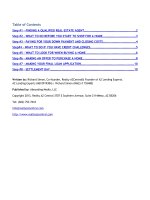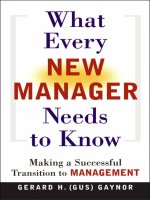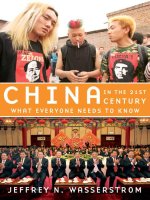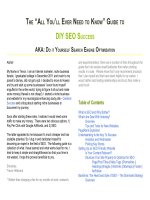Axilord the federal reserve; what everyone needs to know (2013)
Bạn đang xem bản rút gọn của tài liệu. Xem và tải ngay bản đầy đủ của tài liệu tại đây (529.71 KB, 156 trang )
THE FEDERAL RESERVE
WHAT EVERYONE NEEDS TO KNOW
This page intentionally left blank
THE FEDERAL
RESERVE
WHAT EVERYONE NEEDS TO KNOW
STEPHEN H. AXILROD
1
3
Oxford University Press is a department of the University of Oxford.
It furthers the University’s objective of excellence in research, scholarship,
and education by publishing worldwide.
Oxford New York
Auckland Cape Town Dar es Salaam Hong Kong Karachi
Kuala Lumpur Madrid Melbourne Mexico City Nairobi
New Delhi Shanghai Taipei Toronto
With offices in
Argentina Austria Brazil Chile Czech Republic France Greece
Guatemala Hungary Italy Japan Poland Portugal Singapore
South Korea Switzerland Thailand Turkey Ukraine Vietnam
Oxford is a registered trademark of Oxford University Press
in the UK and certain other countries.
Published in the United States of America by Oxford University Press
198 Madison Avenue, New York, NY 10016
© Oxford University Press 2013
All rights reserved. No part of this publication may be reproduced, stored
in a retrieval system, or transmitted, in any form or by any means, without
the prior permission in writing of Oxford University Press, or as expressly
permitted by law, by license, or under terms agreed with the appropriate
reproduction rights organization. Inquiries concerning reproduction
outside the scope of the above should be sent to the Rights Department,
Oxford University Press, at the address above.
You must not circulate this work in any other form
and you must impose this same condition on any acquirer.
Library of Congress Cataloging-in-Publication Data
Axilrod, S. H.
The Federal Reserve : what everyone needs to know / Stephen H. Axilrod.
pages cm
ISBN 978–0–19–993448–5 (hardcover : alk. paper)—ISBN 978–0–19–993447–8
(pbk. : alk. paper)—ISBN (invalid) 978–0–19–993449–2 (updf)
1. Board of Governors of the Federal Reserve System (U.S.)
2. Federal Reserve banks. 3. Monetary policy—United States.
4. United States—Economic policy.
I. Title.
HG2563.A95 2013
332.1′10973—dc23
2012046769
1 3 5 7 9 8 6 4 2
Printed in the United States of America
on acid-free paper
CONTENTS
PREFACE
xi
1 Introduction
1
Why is the Federal Reserve (the Fed) so important to the country?
1
When and why was the Fed founded?
1
How did the Fed evolve?
2
How in general does the Fed compare with other central banks?
3
How does a central bank differ from other banks and
financial institutions?
6
How do the Fed’s unique policy instruments affect the
nation’s economy as a whole?
7
If so crucial to national policy, why is the Fed independent
of the government?
8
2 The Fed’s Organization for Policy
10
Where does responsibility for monetary policy
decisions reside in the Fed?
10
What does the FOMC do and how is it organized?
11
How are other monetary policy instruments controlled?
11
vi
Contents
How is the politically appointed Board of Governors chosen?
13
How are Reserve Banks governed?
14
What role do Reserve Banks play in the policy process?
15
Should the regional structure of the Fed be modified
for today’s world?
16
Should Reserve Bank presidents be politically appointed?
18
Do member banks and directors of Federal Reserve
Banks unduly profit or exert influence?
19
What happens to the profits from Fed operations?
22
What is the underlying connection between the
government and the Fed?
23
How does the government keep tabs on the Fed?
25
What does it mean in practice to say the Fed is independent?
26
3 Basic Monetary Policy Objectives
28
What are the Fed’s basic objectives?
28
How does the Fed take account of it long-run economic goals?
29
What role does the Fed chairman play in focusing
the institution’s goals?
30
In what sense are the Fed’s monetary policy objectives
compatible with each other?
31
What does price stability mean?
34
What makes the Fed prefer a little rather than no
inflation as its practical goal?
34
What inflation rate seems to satisfy the goal of price stability?
37
Has the Fed specified a target rate of inflation?
38
4 Instruments of Monetary Policy
How are the Fed’s monetary instruments employed
in the policy process?
41
41
Contents
vii
Which of the Fed’s instruments are most significant
for implementing policy?
43
How are open market operations employed in policy implementation?
45
How does the federal funds rate connect with money
market conditions in general?
47
How does the funds rate decision affect other credit markets?
49
How do key borrowers respond to changed market conditions?
50
How do FOMC policy decisions adapt to market uncertainties?
52
How do open market operations avoid creating too much
money and inflation?
53
Does the money market itself influence spending
or is it mostly a policy conduit?
57
Are the Fed’s powers also used to influence the
government securities market?
59
5 The Formulation and Communication
of Monetary Policy
64
What is the institutional structure for monetary policy decisions?
64
What material is provided to the FOMC for discussion
of the economic outlook?
66
What material is provided to help the Committee form
its monetary policy decision?
68
How do Committee members conduct their discussion
of the economy and monetary policy?
70
What, in general, are the main influences on
the Fed’s policy decision?
72
How do Committee members frame and communicate
their decision about policy?
74
How influential is the chairman in the policy votes?
77
Why has the Fed become much more open about policy
in recent decades?
78
Can there be too much openness?
80
viii
Contents
6 The Fed’s Role, Other Domestic Policies,
and Conditions Abroad
84
What policies outside the Fed’s control most influence
its policy effectiveness?
84
How do fiscal and monetary policies best fit together?
86
How are decisions about coordinate roles of fiscal and
monetary policies made in practice?
91
How do regulatory issues relate to monetary policy and
its dual economic objectives?
94
How does the Fed’s own regulatory authority fit into the
nation’s regulatory structure?
97
How has the Dodd-Frank Act influenced the Fed’s
regulatory stance?
99
How might the Fed better integrate monetary and
regulatory policies?
103
How is Fed policy influenced by policies and
conditions abroad?
105
Will the Fed’s ability to make monetary policy decisions on
purely domestic grounds be significantly lessened by further
integration of world financial markets?
108
7 The Fed’s Two Great Postwar Crises
111
In what ways are the two great postwar crises similar?
111
How did the Fed becomes involved in the great inflation’s onset?
112
How did the Fed control inflation and regain credibility?
113
What again destabilized the economic and financial
background for Fed policy?
115
How did the Fed become involved in the great credit crisis?
116
What actions did the Fed take to help contain the crisis?
119
How did the Fed contribute to the recovery?
120
What lessons can be learned from the Fed’s management
of the two great postwar crises?
122
Contents
8 Conclusion
ix
127
What major challenges face the Fed as an organization
in the future?
127
How well has the Fed served the country?
130
APPENDIX A-1
133
APPENDIX A-2
135
INDEX
137
This page intentionally left blank
PREFACE
This book aims to clarify for a broad public audience what
the Federal Reserve System, the nation’s central bank, does,
while still being of interest to former colleagues and others
who study and evaluate its practices. It emphasizes the institution’s principal function of monetary policy, including closely
related financial and regulatory issues, and answers questions
about what are its capabilities and limitations and why it does
what it does.
A central bank is an entity with singularly enormous powers to influence financial markets and the economy, given to
it by the nation through the legislative process. Historically,
the Federal Reserve’s workings have been little understood
by the public. However, in recent decades—featuring worries
about too much inflation, fears of deflation, and most recently
the debilitating aftermath of what appears to have been the
granddaddy of all credit crises—it has become much more
widely discussed in the media, often abused and occasionally
praised.
It has been dragged into the open air where, indeed, it
long ought to have been. In those circumstances, the Federal
Reserve has become more and more forthcoming about its
intentions, motivations, actual policy decisions made, and
future prospects.
xii
Preface
This writer has experienced the Federal Reserve and how
its policies have been formulated in the post–World War II
period from both a first-hand, inside perspective and an outside perspective not far from the line of fire. First, almost three
and a half decades were spent on the inside, much of the time
working closely on policy with the chairmen of the period.
Subsequently, more than two active decades have been spent
closely observing the Fed from an outside market perspective,
for some years as a high official of a foreign (Japanese) securities
firm on Wall Street, and then as an independent market consultant both in the United States and abroad (the latter mainly
as a consultant to foreign central banks in countries making
the transition to a more modern operating framework). These
inside and outside views in retrospect seem to have, to use an
analogy, leavened the bread with a mixture (sweet, sour, and
in between) that should improve its texture, though taste may
always be in dispute.
My views about the Fed and thoughts about “what
everyone needs to know”—the writ offered by the Oxford
University Press—were influenced not only by firsthand and
close continuing observations of the institution’s doings but
also by the many fascinating and knowledgeable people I met
along the way. The list would be far too long to individualize
and includes not only central bank officials here and abroad
(many of whom were economists) but also academic thinkers on the subject, market participants struggling to understand what the institution was up to, envoys of the political
world who might have the same problem, and others—like
friends and neighbors—who ask questions, some with puzzled looks.
With respect to this particular book, I would like to give
thanks to Ed Nelson, a widely experienced monetary and macro-economist, currently an assistant director in the Division
of Monetary Affairs at the Board of Governors of the Federal
Reserve System. He read through an early draft of the text and
provided a number of specific and helpful technical comments.
Preface
xiii
All remaining errors are my responsibility, and so, of course,
are all opinions and interpretations.
I would also like to recognize, with love, my wife, Kathy,
who withstood her husband’s ups and downs as he tried to
figure out not only what the public needs to know, but also
how to clarify in his own mind the complex, continually evolving issues for policy and the Federal Reserve that have been
unveiled by the great credit crisis and its difficult aftermath.
This page intentionally left blank
1
INTRODUCTION
Why is the Federal Reserve (the Fed) so important to the country?
The Fed is the nation’s central bank and, as authorized by
law, independently determines the country’s monetary policy.
It has a unique capacity to control inflation, helps moderate
cyclical ups and downs in the economy, and acts as a buffer
against potentially destabilizing financial and credit market
conditions. Policy is normally implemented mainly through
three traditional policy instruments: open market operations
in government securities, lending via its discount window,
and setting reserve requirements on bank deposits.
The Fed also has an important role in establishing the
nation’s regulatory policies in the financial area, especially as
they apply to commercial banks and certain related entities.
Such policies can impinge on and interact with monetary policy and the use of monetary instruments. While a central bank’s
monetary policy function is special, its regulatory role is similar
to, and shared with, other regulatory authorities in the country.
Many, but not all, central banks around the world combine both
monetary policy and a certain regulatory authority.
When and why was the Fed founded?
The Fed was originally established in December 1913 under very
different economic and financial conditions than currently exist
2
THE FEDERAL RESERVE
in the United States and the rest of the world. At that time, the
financial panics and breakdowns in the banking system that had
all too frequently unsettled our economy impelled the Congress
to create an institution (the Federal Reserve System) with lending, regulatory, and other powers that could, it was thought,
moderate, if not avert, significant financial disruptions.
How did the Fed evolve?
The original Federal Reserve Act was subsequently modified
a number of times. As experience was gained with the central bank’s basic monetary policy instruments, their unique
influence on the nation’s overall credit and money conditions
became better understood. At the same time, the United States
developed into a major worldwide financial and economic
power, with increasingly dynamic, and unfortunately still
occasionally crisis-prone, markets; the stock market crisis of
1929, the banking crisis of the early 1930s, and the credit crisis
of 2008–2009 were among the most notable. Practical experience and ongoing economic research helped guide legislative
changes that affected the economic and financial role of the
Fed and its monetary policy objectives, but not without considerable and occasionally acrimonious debate.
Monetary policy came to be clearly recognized as one of the
two major so-called macro-economic tools, along with the U.S.
government’s fiscal policy, which help to assure that everyone
who wants a job can get one and that the average level of prices
remains generally stable. Like other central banks around the
world, the Fed is especially concerned with maintaining reasonable price stability over time. In the course of the great inflation
of the 1970s, the public became increasingly aware of the institution’s responsibilities to contain inflation. But it also makes
decisions to help keep economic activity on an even keel and to
avert dangerous financial instabilities—issues that brought the
Fed under enormous public and political scrutiny as the great
credit crisis of 2008–2009 and its aftermath unfolded.
Introduction
3
The Fed will celebrate its 100th anniversary in 2013. The Fed
of today came into its own after amendments to the Federal
Reserve Act by the mid-1930s improved, among other things,
the organizational basis for policy, and after 1951, when the
institution was freed from agreed restraints that helped finance
the Second World War at low interest rates. This book will draw
mainly on the experiences of the post–World War II years in its
discussion of the monetary policy structure and operation of
the institution, along with regulatory issues that have been so
prominently raised in recent years in connection with the Fed
and monetary policy.
How in general does the Fed compare with other central banks?
Central banks are a familiar species in our modern world. They
come in all shapes and sizes, and are freighted with varying
responsibilities and degrees of independence from the central
government.
Central banks have been prevalent and important to economic and financial policy in the developed world for a long
time. In recent decades, as political conditions and economic
philosophies have changed around the world, central banks in
emerging and less developed countries have begun to evolve,
quite slowly in many instances, toward modern-style central
banks with powers more typical of those in the developed
world. How advanced or not a central bank may be, and while
differing in a number of important respects, they all tend to
feature, in one way or another, the essential central banking
power for strongly influencing overall credit and money conditions in the country.
As a central bank, the Fed is akin to diverse institutions
among the major economic countries of the world such as the
Bank of England (BoE) in the United Kingdom, the European
Central Bank (ECB), the Bank of Japan (BoJ) and, although
rather more remotely, the Peoples Bank of China (PBC). All
except the PBC have a certain amount of basic independence
4
THE FEDERAL RESERVE
like the Fed and wield their policy instruments in similar ways.
In practice, the PBC differs in both respects at the present time.
However, the regulatory roles among major central banks differ and seem to be in a state of flux.
The BoE, whose day-to-day monetary operations are rather
similar to those of the Fed, has not been spared from the recent
spate of financial crises afflicting financially important countries or currency areas. Interestingly enough, the crisis was,
as in the United States, attributed in good part to inadequate
regulation. The result was to transfer back to the BoE responsibilities that had been transferred out not so long before as
a result of political dissatisfaction with an earlier regulatory
oversight by the bank. What goes around comes around, so
it would seem. The BoE could, and did, of course continue to
carry out its monetary policy without regulatory authority, but
regulatory authority apparently could not be handled effectively without a key role for the BoE.
The crisis in the United States initially caused a huge adverse
political reaction to the Fed’s handling of its regulatory responsibilities, including many threats to remove them. In the end,
some peripheral ones were removed, but other important ones
were added by new fundamental financial legislation passed
in 2010.
The ECB, unlike other central banks, is not the bank for a single country with its own overriding political and social system
and fiscal authority. Rather, the ECB serves as the sole monetary
and currency authority for a large group of countries (17 as of
this writing) within the European Union that employ the Euro
as their common currency. Regulatory and supervisory responsibilities for banks and other financial institutions are dispersed
among the individual countries of both the Euro zone and the
EU as a whole. Of course, continuing efforts at coordination are
undertaken through various mechanisms within the area, and
greater efforts to bring regulation more closely into harmony
were set in motion by the intensified Euro credit crisis of very
recent years.
Introduction
5
Nonetheless, it appears to be the weakness in central political leadership and of fiscal coordination in the Euro zone that
has most prominently created the potential for severe economic
and market tensions associated with the recent credit crisis,
although regulatory decentralization has not been without its
problems in that respect. The widely publicized Euro credit
crisis of 2011–2012 (which had been festering for some time)
was highlighted by unsustainably expansive fiscal (and also
in some cases instances private sector) policies in a few countries that generated far too much of a debt burden for them
to handle. This in turn threatened the systemic stability and
credibility of the Euro banking and market as whole, as the
questionable debt was widely held throughout the system.
The PBC, unlike the Fed, is an integral part of the executive branch of the Chinese government; the PBC’s fundamental decisions are dependent on higher authorities. It has been
slowly modernized—gradually given more powers (such as
greater control of loans made by its regional offices) to make it
more effective in implementing a national monetary policy. But
because of the lack of breadth and depth in Chinese banking
and financial markets, the PBC so far relies mostly on reserve
requirement changes at banks and terms and conditions at its
discount windows to signal policy shifts toward tightening or
easing, rather than open market operations.
Many other countries have made efforts to modernize their
central banks in recent decades. In Eastern Europe, some had
originally been established in highly controlled economies
(such as the USSR) and had been in business merely to dispense
loan funds when and where needed to meet some national
economic plan. With the fall of communism, the central banks
in Russia and the former satellite countries were refitted by the
newly established regimes with monetary instruments geared
to influencing overall credit market conditions and economic
activity and prices. Generally, however, they would seem to be
without a significant capability for establishing monetary policies based on their own best judgments.
6
THE FEDERAL RESERVE
Around our rapidly integrating economic and financial
world, central banks, such as those in the Middle East and
North Africa, are attempting to find their way to more active
and constructive roles in countries that are looking toward stable growth and financial stability in an increasingly interactive
and competitive global economic environment.
How does a central bank differ from other banks and
financial institutions?
As a basis for monetary policy, all central banks have certain
features in common that, unlike individual commercial banks
and other depository and financial institutions, give them the
potential for unrivaled and enormous influence in financial
markets and the economy. For one, they are, as the bankers’
bank, the ultimate source of loans to commercial banks and certain other depositories; they hold working balances (including
required reserves, if any) behind deposits for the institutions and
provide clearing and payments services. For another, the central banks’ writ from the government permits them to acquire
other assets, mainly government and government-guaranteed
securities and to a certain extent other types of securities. These
two features mean that central banks in effect have the power
to create money, liquidity, and credit out of thin air.
It happens, illustratively, this way. To get the funds for assets
it buys or for loans that it may make, a central bank, unlike
ordinary businesses, does not have to draw down any of its
existing assets, borrow or raise equity from another entity or
the public, or divert income. The central bank pays by simply crediting the reserve balance accounts it holds for member
banks for the asset or loan it takes on.
Since any individual commercial bank normally needs to
hold only some fraction (often quite small) of its deposits as
reserves at the central bank for operating and legal purposes,
the reserve balances are quickly spread throughout the banking
system (aided by the efficient interbank federal funds market
Introduction
7
in the United States). They provide the base for a rather rapid,
multiple expansion in bank credit and deposits that also affects,
through customer linkages, financial markets and interest rates
more broadly throughout the economy.
How do the Fed’s unique policy instruments affect the
nation’s economy as a whole?
In response to the emerging interest rate effects and changes
in credit availability and liquidity from the Fed’s actions, the
nation’s economic well-being will be eventually affected in one
way or another—indicated by the behavior of economic activity, employment, and the average level of prices. In practice, it
takes some time for those influences to be felt. Moreover, the
Fed’s degree of influence is not easy to distinguish, given all the
other influences, both domestic and international, that weigh
on the economy. Over the long run, however, a central bank
with its power to create money out of nothing, so to speak, does
bear a clear, special responsibility for the behavior of inflation.
A central bank’s powers to create credit or money, in addition to being crucial to its monetary policy function, also serve
as a buffer against destabilizing and economically disruptive
financial crises. The recent credit crises in the United States
and subsequently in Europe, for instance, were contained, at
least to a degree, through an unusually large expansion in the
balance sheet of central banks as they provided funds to markets that were being dragged down by bad debts.
In general, the Fed and other central banks can be viewed
as unique institutions that, in their money- and credit-creating
powers, have the power independently, from on high as it
were, to tilt the ongoing balance of supply and demand in
financial markets. They are something like the proverbial deus
ex machina that usefully appears in a literary work from out of
nowhere and transforms its plot. However, central banks cannot control the ensuing plot development like an author can,
and the eventual outcomes of their intervention are shrouded
8
THE FEDERAL RESERVE
in uncertainty even if the direction appears clear. That, by the
way, is essentially why good central banking depends so much
on sound judgment and an almost intuitive feel for markets
by its leadership as much as, or more than, practically useful
results of economic analysis and research.
If so crucial to national policy, why is the Fed independent
of the government?
Central banks that are considered independent, such as the
Fed, are essentially independent within the government, but,
they are by no means independent of the government. In the
United States, for example, the Fed’s powers are granted by
Congress and can be altered by that body (and, of course, are
subject to presidential veto and judicial review). The practical test of a central bank’s monetary policy independence is
the extent to which it can determine its monetary policy stance
and make operating decisions without approval by the executive branch of the government.
It is the enormous powers inherent in the structure of a
central bank that both entice governments to maintain direct
control over the bank through its executive branch and also
provide incentives to give its central bank a certain degree of
independence. At this point in time, central banks in developed, democratic countries have in fact been given a significant
degree of independence in decision-making about monetary
policy and its implementation.
Partly, this has been to help ensure that the powers of the
central bank are not used to doctor markets during election
periods to favor the incumbent party. But importantly, over the
past several decades, it has reflected growing recognition that
it is in everyone’s interest to keep inflation in check over time
and that the central bank, as the institution with unique powers to do so, should be distanced from politics so it can more
readily focus on its principal task of keeping inflation down by
controlling the nation’s monetary base.
Introduction
9
Early in the post–World War II period, a then long-serving
chairman of the Fed, William McChesney Martin, took to
describing the Fed as independent within the government (a
phrase that he probably did not originate). He also became
well-known for aptly describing the Fed’s principal problem
by noting that it was the institution’s (unhappy) job to take the
punch bowl away once the party really got going.
But when exactly is that? The art of central banking is largely
in the timing, plus a feel for how markets might respond under
circumstances of the period—not easy to get right, given all the
conflicting signals and tendencies in an economy, in its markets, and in its connections to the rest of the world.
2
THE FED’S ORGANIZATION
FOR POLICY
Where does responsibility for monetary policy decisions
reside in the Fed?
Though organized as a regional system, with 12 Federal
Reserve Banks around the country, monetary policy and
other major decisions are made on a national basis. The dominant role is played by the seven-person politically appointed
Board of Governors of the Federal Reserve System located in
Washington, DC. The Board also oversees operations of the
Reserve Banks and approves key decisions such as who will
be named presidents of them.
As to monetary policy, Board members are the majority of
the 12-member Federal Open Market Committee (FOMC), the
central monetary policymaking body within the Fed. It was
established by law in early amendments to the Act, attaining
its present form in 1942. In addition to seven Board members,
the committee includes the president of the Federal Reserve
Bank of New York and four of the 11 other regional Reserve
Bank presidents serving in annual rotations. The nonvoting
presidents also sit at the table at each meeting and participate
fully in policy discussions.









